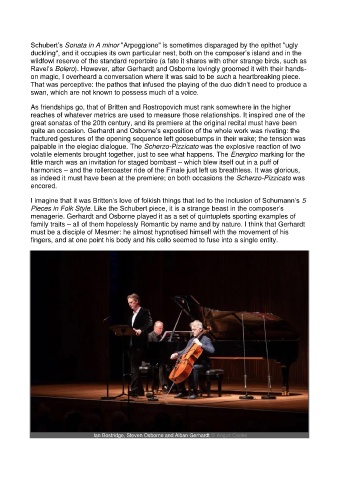Page 546 - Media Coverage Book - 75th Aldeburgh Festival 2024
P. 546
Schubert’s Sonata in A minor "Arpeggione" is sometimes disparaged by the epithet "ugly
duckling", and it occupies its own particular nest, both on the composer’s island and in the
wildfowl reserve of the standard repertoire (a fate it shares with other strange birds, such as
Ravel’s Bolero). However, after Gerhardt and Osborne lovingly groomed it with their hands-
on magic, I overheard a conversation where it was said to be such a heartbreaking piece.
That was perceptive: the pathos that infused the playing of the duo didn’t need to produce a
swan, which are not known to possess much of a voice.
As friendships go, that of Britten and Rostropovich must rank somewhere in the higher
reaches of whatever metrics are used to measure those relationships. It inspired one of the
great sonatas of the 20th century, and its premiere at the original recital must have been
quite an occasion. Gerhardt and Osborne’s exposition of the whole work was riveting: the
fractured gestures of the opening sequence left goosebumps in their wake; the tension was
palpable in the elegiac dialogue. The Scherzo-Pizzicato was the explosive reaction of two
volatile elements brought together, just to see what happens. The Energico marking for the
little march was an invitation for staged bombast – which blew itself out in a puff of
harmonics – and the rollercoaster ride of the Finale just left us breathless. It was glorious,
as indeed it must have been at the premiere; on both occasions the Scherzo-Pizzicato was
encored.
I imagine that it was Britten’s love of folkish things that led to the inclusion of Schumann’s 5
Pieces in Folk Style. Like the Schubert piece, it is a strange beast in the composer’s
menagerie. Gerhardt and Osborne played it as a set of quintuplets sporting examples of
family traits – all of them hopelessly Romantic by name and by nature. I think that Gerhardt
must be a disciple of Mesmer: he almost hypnotised himself with the movement of his
fingers, and at one point his body and his cello seemed to fuse into a single entity.
Ian Bostridge, Steven Osborne and Alban Gerhardt © Angus Cooke

